Neuromancer1 and Neuromancer2 regulate cell fate specification in the developing embryonic CNS of Drosophila melanogaster
- PMID: 19013145
- PMCID: PMC2648533
- DOI: 10.1016/j.ydbio.2008.10.006
Neuromancer1 and Neuromancer2 regulate cell fate specification in the developing embryonic CNS of Drosophila melanogaster
Abstract
T-box genes encode a large family of transcription factors that regulate many developmental processes in vertebrates and invertebrates. In addition to their roles in regulating embryonic heart and epidermal development in Drosophila, we provide evidence that the T-box transcription factors neuromancer1 (nmr1) and neuromancer2 (nmr2) play key roles in embryonic CNS development. We verify that nmr1 and nmr2 function in a partially redundant manner to regulate neuronal cell fate by inhibiting even-skipped (eve) expression in specific cells in the CNS. Consistent with their redundant function, nmr1 and nmr2 exhibit overlapping yet distinct protein expression profiles within the CNS. Of note, nmr2 transcript and protein are expressed in identical patterns of segment polarity stripes, defined sets of neuroblasts, many ganglion mother cells and discrete populations of neurons. However, while we observe nmr1 transcripts in segment polarity stripes and specific neural precursors in early stages of CNS development, we first detect Nmr1 protein in later stages of CNS development where it is restricted to discrete subsets of Nmr2-positive neurons. Expression studies identify nearly all Nmr1/2 co-expressing neurons as interneurons, while a single Eve-positive U/CQ motor neuron weakly co-expresses Nmr2. Lineage studies map a subset of Nmr1/2-positive neurons to neuroblast lineages 2-2, 6-1, and 6-2 while genetic studies reveal that nmr2 collaborates with nkx6 to regulate eve expression in the CNS. Thus, nmr1 and nmr2 appear to act together as members of the combinatorial code of transcription factors that govern neuronal subtype identity in the CNS.
Figures

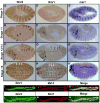
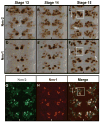

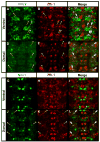

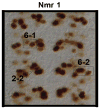

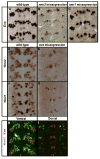

Similar articles
-
Neuromancer Tbx20-related genes (H15/midline) promote cell fate specification and morphogenesis of the Drosophila heart.Dev Biol. 2005 Mar 15;279(2):509-24. doi: 10.1016/j.ydbio.2005.01.013. Dev Biol. 2005. PMID: 15733676
-
Differential and redundant functions of gooseberry and gooseberry neuro in the central nervous system and segmentation of the Drosophila embryo.Dev Biol. 2013 Oct 1;382(1):209-23. doi: 10.1016/j.ydbio.2013.05.017. Epub 2013 Jul 22. Dev Biol. 2013. PMID: 23886579
-
Identification of Ind transcription activation and repression domains required for dorsoventral patterning of the CNS.Mech Dev. 2009 Jul;126(7):552-62. doi: 10.1016/j.mod.2009.03.008. Epub 2009 Apr 5. Mech Dev. 2009. PMID: 19348939 Free PMC article.
-
Drosophila Embryonic CNS Development: Neurogenesis, Gliogenesis, Cell Fate, and Differentiation.Genetics. 2019 Dec;213(4):1111-1144. doi: 10.1534/genetics.119.300974. Genetics. 2019. PMID: 31796551 Free PMC article. Review.
-
40 years of homeodomain transcription factors in the Drosophila nervous system.Development. 2024 Jun 1;151(11):dev202910. doi: 10.1242/dev.202910. Epub 2024 May 31. Development. 2024. PMID: 38819456 Free PMC article. Review.
Cited by
-
Single-cell transcriptomics of the Drosophila wing disc reveals instructive epithelium-to-myoblast interactions.Elife. 2021 Mar 22;10:e61276. doi: 10.7554/eLife.61276. Elife. 2021. PMID: 33749594 Free PMC article.
-
The nutrient sensor CRTC and Sarcalumenin/thinman represent an alternate pathway in cardiac hypertrophy.Cell Rep. 2024 Aug 27;43(8):114549. doi: 10.1016/j.celrep.2024.114549. Epub 2024 Aug 1. Cell Rep. 2024. PMID: 39093699 Free PMC article.
-
Diversification of heart progenitor cells by EGF signaling and differential modulation of ETS protein activity.Elife. 2018 Jun 5;7:e32847. doi: 10.7554/eLife.32847. Elife. 2018. PMID: 29869981 Free PMC article.
-
The Drosophila Transcription Factors Tinman and Pannier Activate and Collaborate with Myocyte Enhancer Factor-2 to Promote Heart Cell Fate.PLoS One. 2015 Jul 30;10(7):e0132965. doi: 10.1371/journal.pone.0132965. eCollection 2015. PLoS One. 2015. PMID: 26225919 Free PMC article.
-
Axonal commissures in the central nervous system: how to cross the midline?Cell Mol Life Sci. 2011 Aug;68(15):2539-53. doi: 10.1007/s00018-011-0691-9. Epub 2011 May 3. Cell Mol Life Sci. 2011. PMID: 21538161 Free PMC article. Review.
References
-
- Adell T, Muller WE. Expression pattern of the Brachyury and Tbx2 homologues from the sponge Suberites domuncula. Biol Cell. 2005;97:641–650. - PubMed
-
- Ahn DG, Ruvinsky I, Oates AC, et al. tbx20, a new vertebrate T-box gene expressed in the cranial motor neurons and developing cardiovascular structures in zebrafish. Mech Dev. 2000;95:253–258. - PubMed
-
- Alexandre C, Lecourtois M, Vincent J. Wingless and Hedgehog pattern Drosophila denticle belts by regulating the production of short-range signals. Development. 1999;126:689–98. - PubMed
-
- Bossing T, Brand AH. Determination of cell fate along the anteroposterior axis of the Drosophila ventral midline. Development. 2006;133:1001–1012. - PubMed
Publication types
MeSH terms
Substances
Grants and funding
LinkOut - more resources
Full Text Sources
Molecular Biology Databases

